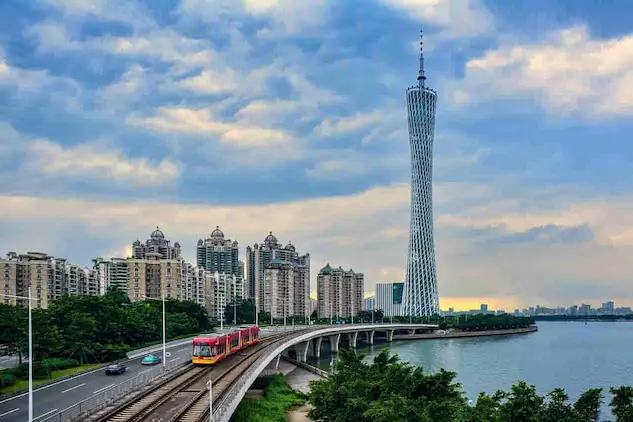The integration of China’s highway infrastructure with the growing low-altitude economy offers a cost-effective way to expand transport capacity. By converting underused service areas into drone hubs, upgrading navigation systems, and coordinating energy networks, the model can improve logistics efficiency, strengthen emergency response, and reduce emissions. This approach promises significant economic returns and social value, provided that policy, technology, and community engagement advance in step. The article is provided by our media partner 7ITSNEWS.
With the rapid advancement of drone technology and reforms in low-altitude airspace management, drone logistics, emergency response, surveying, and inspection have emerged as globally significant sectors of the low-altitude economy in recent years. However, the primary bottleneck for its large-scale development lies in the lack of low-altitude transportation infrastructure—such as takeoff/landing sites, communication/navigation facilities, and energy supply stations—as well as the absence of operational mechanisms coordinating low-altitude airspace with ground transportation.
Against this backdrop, China’s national highway network has evolved into a vast transportation system, while its ancillary resources (service areas, communication towers, power infrastructure, etc.) remain significantly underutilized. Highway service areas nationwide operate at less than 60% efficiency on average, and their communication base stations are exclusively used by traffic monitoring authorities, with data inaccessible to other departments. This idle and mismatched state of highway resources presents a strategic opportunity for integrating highways with low-altitude economic development. Repurposing highway assets into low-altitude infrastructure can reduce initial investment, revitalize underutilized assets, and create an integrated “ground + low-altitude” transportation network, collectively enhancing efficiency, emergency response, and regional economic vitality.

Mechanisms and foundations for synergistic development
Resource matching logic: spatial and functional synergy
Highways and short-haul drone logistics are inherently compatible. China’s 160,000+ km highway network—structured around the “71118” national expressway framework—aligns closely with population and economic hubs. Drone logistics applications (e.g., urban/regional delivery) require dense node distribution. Highway service areas, interchanges, and toll stations naturally support “distributed” drone hubs. For instance, in the Yangtze River Delta, service areas spaced ~40 km apart match drones’ 200–300 km range, enabling a “service area-hub-last mile” logistics node system.
Additionally, highway corridors and drone routes share spatial synergies. Flight paths along highways avoid urban clusters, reducing airspace conflicts. For example, the Beijing-Hong Kong-Macao Expressway airspace serves as a test route for “point-to-point” cargo drones, eliminating the need for conventional air routes.
Policy and economic drivers: dual-path coordination
China’s 14th Five-Year Plan for Modern Integrated Transportation System Development (2022) mandates “integrating transport infrastructure with information/energy networks,” providing top-level support. Specific policies include:
– Airspace Pilots: Commercial drone operations permitted along highways in pilot zones (e.g., Greater Bay Area, Chengdu-Chongqing).
– Shared Infrastructure: Highway operators incentivized to invest in low-altitude communication/navigation facilities (tax breaks, subsidies).
– Standardization: Drafting technical standards (e.g., Highway Drone Vertiport Specifications, Air-Ground Coordination Protocols) to eliminate industry barriers.
ICore application strategies
Shared navigation and communication facilities
Highway infrastructure such as base stations, lampposts, and guardrails can be repurposed into key elements of a nationwide drone navigation network. Upgrading service area base stations to dual-mode “Beidou-3 + 5G” systems provides high-precision positioning and low-latency communication, significantly reducing the cost of ground stations while improving delivery accuracy. In one provincial project, collaboration between a highway operator and a logistics firm cut route-planning errors from 0.5 meters to just 0.05 meters, boosting efficiency by 20%.
A unified air–ground dispatch system takes this integration further by combining highway traffic monitoring, drone control, and air traffic data into a single platform for dynamic 3D coordination. During peak travel periods, drones automatically ascend above 120 meters to maintain safe separation from vehicles and infrastructure. In the event of an accident, drones stationed at nearby service areas can be deployed instantly, relaying detailed 3D models of the scene to emergency response centers.
Multi-functional service area upgrades
Service areas are becoming pivotal nodes in the transformation of transport networks. At the base level, idle plots of land—often 100–200 square meters—can be converted into drone pads and emergency storage points. In one province, retrofitted sites now support up to 20 drones per day, covering towns within a 50-kilometer, 30-minute range.
At the expansion level, larger service areas can evolve into fully fledged “logistics hubs + emergency bases.” One example is the joint facility developed by Hubei Transportation Investment and SF Express, which combines automated sorting, cold storage, and medical-response drones capable of delivering 1,500 parcels daily and meeting a 15-minute emergency dispatch target.
Revenue-sharing models further enhance the appeal of these transformations. Land can be leased to drone operators, with dynamic pricing that increases during rush hours; charging facilities can be shared, with revenues split according to usage; and co-branded “Skyway Transit Stations” can draw in third-party logistics providers, creating a new layer of economic activity along the highway network.
Coordinated energy management
Coordinated energy management is not just about optimizing electricity flows—it’s about integrating infrastructure, technology, and emergency readiness into a single, resilient system. This approach ensures that charging networks work harder, serve more purposes, and stay operational when communities need them most. Two key initiatives illustrate how this strategy comes to life.
Unified charging infrastructure.
Upgrading EV chargers to support both vehicles and drones, with 380V output and fast-charging interfaces, is transforming service areas into multi-purpose energy hubs. Smart scheduling technology has boosted utilization rates to over 80%. In one location, daily drone charges increased from 50 to 120, resulting in a substantial rise in annual revenue.
Emergency power priority.
During disasters such as typhoons and wildfires, service areas draw on battery storage to power drones delivering medicine and essential supplies. In Fujian’s 2023 typhoon, drones operated around the clock, completing 23 medical deliveries to isolated communities. Solar generation combined with energy storage further reduces emissions, enhancing the sustainability of the system.
Integrated strategy synergies
Integrated Strategy Synergies bring together three complementary approaches into a seamless, self-reinforcing loop. Advanced navigation and communication systems enable precise drone coordination, ensuring every mission runs efficiently. Strategically located service areas act as both charging hubs and emergency response points, while robust energy networks keep operations running and provide vital support during crises.
This integration is already proving its value. In one provincial pilot project, the combined approach cut drone delivery costs from CNY 5.2 per kilometer to 3.5, reduced logistics times by 40%, enabled emergency response in under 30 minutes, and lowered annual CO₂ emissions by 1,200 tonnes—the equivalent of planting 68,000 trees.

Economic and social benefits assessment
Direct economic benefits of integrating drone operations into China’s transport infrastructure are substantial. Converting just 20% of the nation’s 26,000 service areas into drone bases could generate CNY 5.2 billion in annual rental income. Shared charging stations add another CNY 600 million in yearly revenue. Expanding drone logistics to 30% of counties would save more than CNY 5 billion annually in transportation costs. Even in fresh e-commerce, drones are making an impact—cutting spoilage rates by 8% and driving a 27% boost in sales.
Social benefits go beyond economics. In emergency medical situations, drones can help meet the “15-minute golden rescue window,” increasing survival rates by 18%. During Fujian’s 2023 typhoon, they delivered essential supplies to 12,000 people in isolated areas. On the sustainability front, drones produce only one-fifth of the CO₂ emissions of trucks; replacing 10% of short-haul freight with drones could cut 1.2 million tonnes of emissions each year—the equivalent of planting 6.8 million trees. Shared EV chargers further reduce resource waste by avoiding idle infrastructure.
Challenges and mitigation need to be addressed as the network expands. Potential competition for resources could be reduced through staggered scheduling—such as allocating trucks to daytime use and drones to nighttime operations—and through multi-level deployment, including rooftops and parking structures. Noise and privacy concerns сould be managed with technologies that keep sound levels below 60 decibels, clear no-fly zones, strong data encryption, and public awareness campaigns to build trust. These measures, implemented proactively, can help ensure that drone integration is both efficient and socially acceptable.
Conclusion
Integrating highways with the emerging low-altitude economy has the potential to breathe new life into existing highway assets while enabling cost-effective expansion of transport and logistics networks. The opportunities are clear: converting 20% of service areas could generate CNY 5.2 billion in annual rent, cut logistics costs by a third, and drive 27% growth in fresh e-commerce.
The social benefits are equally compelling. With drone-enabled emergency response times under 30 minutes, survival rates in critical accidents could rise by 18%, while replacing a portion of short-haul freight with low-emission aerial transport could reduce CO₂ emissions by 1.2 million tonnes annually.
Realizing this vision will require careful conflict resolution, from time-sliced use of shared resources to reducing eVTOL noise and actively engaging local communities. Moving forward, priorities include strengthening policy frameworks—such as airspace regulations and co-governance models—advancing technologies like AI-driven dispatch and next-generation energy storage, and forging a true “community of shared interest” between highway and low-altitude stakeholders. Together, these steps can deliver a transport system that is efficient, resilient, and sustainable.
Author: Gao Xue
Source: Is “Highways + Low-Altitude” a Viable Business Model? | 7ITS NEWS

